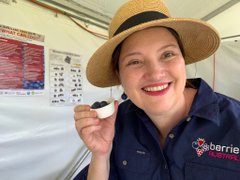Biosecurity Protection Levy submission – Berries Australia
Date: 16th October 2023
Berries Australia has made a submission pushing back on the proposed mandatory biosecurity levy on the basis that it is unfair and inequitable.
Berries Australia is a member of the National Farmers’ Federation Horticulture Council and the PHA Plant Industry forum. As such, we support the basic premise put forward by those entities in their submissions; that there should be significantly more consultation as to how the current biosecurity system could be improved and how industry can best contribute. This includes discussion on how to improve efficiency within the department, how costs are distributed across the risk-creator/beneficiary continuum and the most effective mechanism for industry to contribute to the shared responsibility paradigm.
Shared responsibility is supposedly one of the key principles of modern biosecurity management and is enshrined in legislation. In practice however, it has become more about cost shifting than actually enabling non-government stakeholders a role in decision-making. Never has this been more obvious than in relation to the proposed biosecurity protection levy (BPL). Regardless of the discussion as to whether industry should contribute to additional biosecurity measures, the process around raising these funds has deviated completely from best practice in regard to policy making.
According to the consultation paper, the Biosecurity Protection Levy is a new levy with a separate policy intent and legislative arrangements to the existing agricultural levies and charges (levies) legislation. If this is indeed the case, then there should be a transparent and equitable approach to raising the new levy based on a set of mutually agreed principles. The arbitrary application of a 10% increase to 2020/21 levies, which were raised for an entirely different purpose smacks of an administrative quick fix to fill a budget black hole and will result in enormous inequity across stakeholders, even within the berry category. As such Berries Australia cannot support the proposed levy but is open to ongoing discussions about how to best address the resourcing issues facing our biosecurity system.
As highlighted in other industry submissions, there have been numerous reviews of the biosecurity system, and we request that government works with all stakeholders to effectively implement the recommendations put forward in those reviews. The development of a world class biosecurity system is in everyone’s interests, but it is also reliant on mutual trust and shared decision making. This levy may raise funds for government in the short term but in the longer term it will be counter-productive to the overall goal of improving Australia’s biosecurity system. The current proposal gives us no confidence that the levy will in fact go to improved biosecurity or that there will be any transparency as to how those funds are dispersed.
Berry specific response
The levy ecosystem for the berry industry is quite complicated particularly as many berry growers grow at least two types of berry.
Strawberries
The Australian strawberry industry is worth $417 million/annum. Strawberry growers are currently subject to a statutory levy of $8/1000 runners. Of that, $7.87 contributes to Research and Development and 13c to the PHA levy. The EPPR levy is currently set at zero but will be increased to cover the varroa response. Under the proposed new biosecurity levy, the strawberry industry will contribute an additional $74,000. It should be noted that the value of strawberry production has dropped by 4% since 2020 and levy income has dropped even more as individual runner plants become more productive. If the 2020/21 levy year is used as the basis for the BPL calculation, the $74,000 contribution to the BPL will potentially become proportionally greater over time in relation to the rest of the levy funds. It is estimated that there are around 500 active strawberry growers in Australia.
Rubus
The Rubus industry is worth $205million/annum. Rubus growers have recently amended their levy and from 1 October 2023 are subject to a statutory research and development levy of 2c/kg and a new biosecurity levy of 2c/kg. The industry voted to remove the marketing levy as it was not delivering for the sector. Prior to the levy amendment, the industry paid 12c/kg levy (10c R&D, 2c Marketing).
If the 2020/21 levy year is used as the basis for the BPL calculation the Rubus industry will be contributing an additional $134,000/year. If the current levy rate is used the industry will be contributing an additional $45,000.
If the 2020/21 rate is used, the BPL will actually represent 30% of total levy income. It should also be noted that the Rubus industry has become significantly more concentrated in recent times and there are now only around 60 active growers. The current levy rate also exempts product going to export and processing.
Blueberries
The blueberry industry is worth $407 million/annum currently pays a voluntary levy based on tonnage to the ABGA with the amount decided annually by the committee. The industry currently contributes 2.2c/kg to a collective industry fund (CIF) mechanism which is paid to Hort Innovation. We are currently negotiating with Hort Innovation to increase this to 4.75c/kg. There are approximately 300 active growers.
Nursery products levy
Many berry growers also inadvertently contribute to the nursery products levy as they use modern hydroponic cropping methodology. Berry growers currently derive no benefit from the nursery products levy. We are in active discussions with the department about removing that obligation which is an unintended consequence of a levy mechanism developed more than 30 years ago which did not intend to capture fruit growers. We estimate that berry growers (rubus and blueberry) contribute around $100,000/year to this levy so the imposition of the BPL on top of that will further increase their contribution.
Conclusions
It is clear from this analysis that rubus growers will be disproportionately impacted by the proposed BPL should the allocation be based on the 2020/21 levy income. Essentially an industry worth half the value of strawberries with only 20% of the number of growers will be paying twice as much, without even counting the contribution to the nursery products levy. This cannot be considered reasonable on any measure and highlights that the whole concept is completely arbitrary.
It is particularly galling that the Rubus industry had to go through the full consultation and voting process to undertake the levy amendment and yet the BPL is being shoved through with no consultation and using the old rate as the basis for the industries’ contribution. In addition, we have been advised that the nursery products levy cannot be amended without a consultation process, even though both industry groups and Hort Innovation agree that the inclusion of berry fruit growers was not the intent of the nursery products levy.
It seems there is one rule for government and another for industry when it comes to raising or amending levies!
Whilst we would obviously welcome the recalculation of the Rubus contribution to reflect the new levy rate, this will not address the fundamental issue that the mechanism proposed is not fit for purpose and is not based on any equitable measure. There are numerous examples within the horticulture sector whereby industries with much smaller values are being asked to make much larger contributions on the basis of a levy designed for a completely different purpose. This is without even looking at agriculture as a whole.
The request from government to identify a mechanism and rate for the blueberry industry contribution highlights the absurdity of the approach. How can we possibly come up with a reasonable, proportionate and equitable model when there are absolutely no principles upon which to base our suggestion? The ABGA has chosen not to participate in the statutory system due to concerns with how funds were managed by Hort Innovation and the fact that many blueberry growers were already paying the rubus levy with little ROI (hence the amendment). The blueberry industry is not averse to contributing proportionate to value and risk but there is no ability to understand what that might be based on the current model. We consider there to be no point in putting forward an arbitrary rate and instead call on government to develop an underpinning set of principles for the application of this levy across the whole of agriculture.
The so-called biosecurity protection levy should be called out for what it is – a tax on farmers.
It should also be called out for not being compliant with any of the basic principles underpinning a taxation system which include neutrality, efficiency, certainty and simplicity, effectiveness and fairness and flexibility.
As an industry association representing the interests of our members, we cannot support a proposal that is so manifestly inequitable across different types of berry grower or farmers more generally. Whilst we strongly contend that investment in biosecurity is a public good, if government considers that industry must make an additional contribution to more effective biosecurity, then this contribution must be based on the principles outlined above. In addition, there should be a thorough understanding of the role of risk creators and beneficiaries in the system and meaningful engagement in how the funds are to be utilised.
You can also see the submission made by the National Farmers Federation here:
For further comment please contact Rachel Mackenzie





